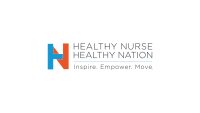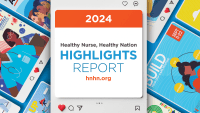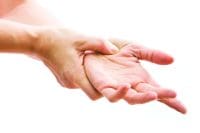Registered nurses educate patients and the public on good health and wellness practices. But many times, nurses themselves are unable to take their own advice due to exposure to occupational hazards, such as infectious diseases, heavy lifting, violence, stress, compassion fatigue, and more. A nurse may spend many hours on his or her feet assisting others, which can leave him or her with little time or energy for exercise, nutritional meal planning, and management of their own health.
The big question is whether nurses, who comprise 1% of the U.S. population, can be more effective role models of wellness and good health to the other 99%. The answer, of course, is yes. To that end, the American Nurses Association (ANA) has built a Healthy Nurse program and website dedicated to helping nurses improve their own health and wellness as well as that of those they influence.
As part of the Healthy Nurse program, in October ANA hosted a national conference entitled Nurses as Models of Wellness in Action*. Nurses came from as far as Washington State to the ANA home office in Silver Spring, Maryland, to discuss and learn about healthy nurse practices and wellness strategies to help nurses be effective role models for their patients and community at large. “Influence, motivate, and model” were the watchwords for the meeting.
Participants received an overview of healthy nurse concepts, including ANA resources, related research, and health policies and services that are available to registered nurses. Additionally, attendees learned about such healthy practices as the following:
- Safe patient-handling practices. Nursing is a physically demanding career; studies show that the average nurse lifts 1.8 tons daily. Participants learned how musculoskeletal disorders (MSD) occur, the rates of MSD in health care, risks to patients from improper movement, ergonomic hazards, benefits of safe patient handling, and ANA’s ergonomic initi-atives. For more on safe patient handling, go to http://www.nursingworld.org/MainMenuCategories/Policy-Advocacy/State/Legislative-Agenda-Reports/State-SafePatientHandling
- Avoiding toxic materials. Participants were advised to look out for and avoid toxic materials, including bisphenol A, mercury, and brominated flame retardants. For more on avoiding toxic materials, go to http://www.nursingworld.org/MainMenuCategories/WorkplaceSafety/Healthy-Work-Environment/hazardouschemicals.
- Proper nutrition and diet. Speakers reviewed healthy food system principles, such as how to support the health of farmers, farm workers, and consumers; how to utilize foods produced by sustainable farming, resilient crops, and herds; and how to recognize fair-trade food practices. Participants also learned healthy cooking practices, such as using fresh, locally grown organic produce. To learn more about diet and nutrition issues, go to http://www.nursingworld.org/MainMenuCategories/WorkplaceSafety/Healthy-Nurse.
- Tobacco cessation. Research indicates that between 7% and 12% of nurses smoke tobacco. The group learned about smoking-cessation strategies, including establishing a quit date, having an available support group, and removing temptation. To learn more about tobacco cessation, go to www.smokefree.gov.
- Stress. The speakers outlined the effects stress has on nurses’ health, including an increase in blood pressure and decreased ability to concentrate, and demonstrated how self-hypnosis, yoga, and calming breathing techniques can help as stress relievers. To learn more about stress-reduction techniques, go to www.cdc.gov/niosh/docs/99-101/.
- Compassion fatigue. This is an intense drain on the body, emotions, and spirit, and it adds to nurse stress. Participants were taught how to identify its symptoms—a constant “empty” feeling, fatigue, isolation, and cognitive impairment—and were given strategies to combat it. To read more about compassion fatigue, check out the Online Journal of Issues in Nursing topic at http://www.nursingworld.org/MainMenuCategories/ANAMarketplace/ANAPeriodicals/OJIN/TableofContents/Vol-16-2011/No1-Jan-2011/Compassion-Fatigue-A-Nurses-Primer.html.
- Immunization. ANA encourages nurses to get vaccinated for seasonal influenza, hepatitis B, Tdap, MMR, and varicella in order to protect their patients and themselves from preventable disease. To learn more about immunizations, go to http://www.nursingworld.org/immunize/.
ANA believes in and supports the healthy nurse and a healthy work environment. Visit ANA’s Healthy Nurse website to find more useful resources at http://www.nursingworld.org/MainMenuCategories/WorkplaceSafety/Healthy-Nurse.
Holly Carpenter is a senior staff specialist at ANA.
*Funding for this activity was made possible in part by the HHS, Office on Women’s Health. The views expressed in written materials or publications and by speakers and moderators at HHS-sponsored conferences do not necessarily reflect the official policies of the Department of Health and Human Services; nor does the mention of trade names, commercial practices, or organizations imply endorsement by the U.S. Government.


















